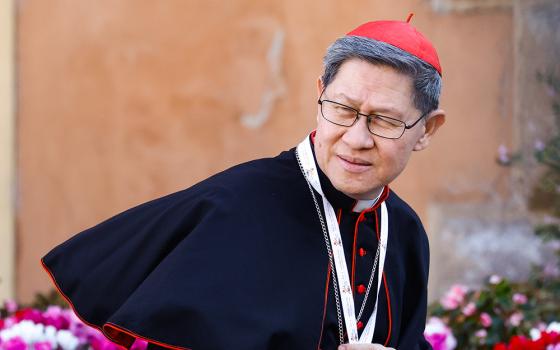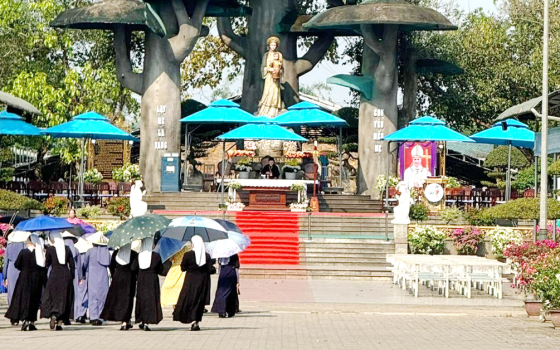LOUISVILLE, Ky. -- James Davidson, a Catholic sociologist of religion from Purdue University in Indiana, believes it's inaccurate to interpret the shrinking number of priests and a decrease in the number of men and women joining religious communities as a general decline in the Catholic Church.
Instead, he said, rising numbers of deacons and lay ecclesial ministers point to a Catholic Church that is vibrant, though perhaps one that will be led in a different way in the future.
Davidson presented a range of data and offered his conclusions during a workshop Oct. 9 at the National Religious Vocation Conference convocation in Louisville Oct. 9-13.
"The church is being transformed as the social context of the laity is being transformed," said Davidson, during an interview with The Record, newspaper of the Louisville Archdiocese. "The strength and vitality of the Catholic Church is in its laity."
Davidson opened his presentation with data that illustrates the decline in the number of vocations to religious life in the United States.
At the same time "the Catholic population in this country," he said, "has been going up rather steadily. We're now about a quarter of the U.S. population."
The Catholic population in the 50 states was less than 50 million in 1979 but grew to more than 59 million in 1999 and 64.4 million today, according to the Official Catholic Directory. That growth has roughly mirrored the rise in total U.S. population, from 218.6 million in 1979 to 232.4 million in 1999 and 300.7 million in 2007.
The number of diocesan priests has dropped from about 35,000 in 1965 to about 28,000 today, according to the directory. Overall, including religious order priests, the numbers are down from about 58,000 in 1965 to about 42,000 today.
There are less than half as many religious brothers today -- 5,000 -- as there were in 1965, when there were more than 12,000, and women religious have decreased in number from more than 180,000 to about 65,000 today.
Davidson noted that among mainstream churches in the United States the Catholic Church is the only one to see a decrease in clergy. The Episcopal Church has seen a nearly 30 percent increase and the United Methodist Church is up 21 percent. The Presbyterian Church (U.S.A.) has had a modest gain of 3 percent.
But he said in "other Catholic vocations the numbers have gone up steadily," with more deacons and lay ministers. "The church is changing to new circumstances. Catholics are saying they have an alternative" to traditional religious life, he said.
The permanent diaconate was restored by Pope Paul VI in 1967, and it has grown steadily since, said Davidson. In 1975 in the U.S., for example, there were 898 deacons, and by 1985 there were 7,200, he said. Today, nearly 16,000 deacons serve the U.S. church. As far as lay ministers, he said, there were more than 30,000 in 2005, the most recent year for which he had statistics.
Around the world Catholic vocation numbers seem to correlate to a nation's wealth, Davidson noted.
Vocations to the priesthood in other First World countries are declining in the same way as in the U.S., and in Third World countries vocations are thriving.
But he cautioned against viewing this trend as permanent. In the U.S. in the 1950s and '60s, vocations were booming, he said, but those were record highs for the country. In the early part of the last century, the church was underserved in the U.S., he said.
Davidson said many factors may contribute to the decline in traditional religious vocations.
For Catholics who came of age 40 or 50 years ago, "faith is closely associated with the church -- love and support of the church itself," Davidson noted.
Today's youths are more interested in an individual approach to faith and are "less attached to church," he said.
"The beliefs and practices of laypeople are changing -- there's more spirituality and less religiosity," he said, meaning "that a pool of people comfortable making a lifelong commitment to religious life is diminishing."
Davidson claimed that many young people responding today to a call to religious life tend to be more aligned with perspectives of an earlier generation of Catholics.
He also said a generation gap exists between vocation directors and the young adults they are hoping to recruit.
In addition, he said, many candidates for religious vocations today are coming from other cultures. Differences of race, custom and language can make it more difficult for vocation ministers -- who in the U.S. are mostly white and of Western European descent.
"The laity today are likely to see priests as different from them but not any better," he continued, noting that contributing to this was a movement after the Second Vatican Council to see priests as servant-leaders. The laity doesn't "put priests on a pedestal the way they used to," he said.
Yet, he said, priests and religious make the same sacrifices, such as celibacy and chastity, that they always did.
Davidson said the approach to recruitment needs to be rethought, as do ways to retain new priests and religious. A quarter of the newly professed and newly ordained leave religious life, he said.
"Recruitment requires relationships," he said, using the example of how colleges recruit athletes.
Coaches "build intense relationships with their players and tell them, 'We're recruiting you because we love you and want you to be a part of our team,'" said Davidson.





